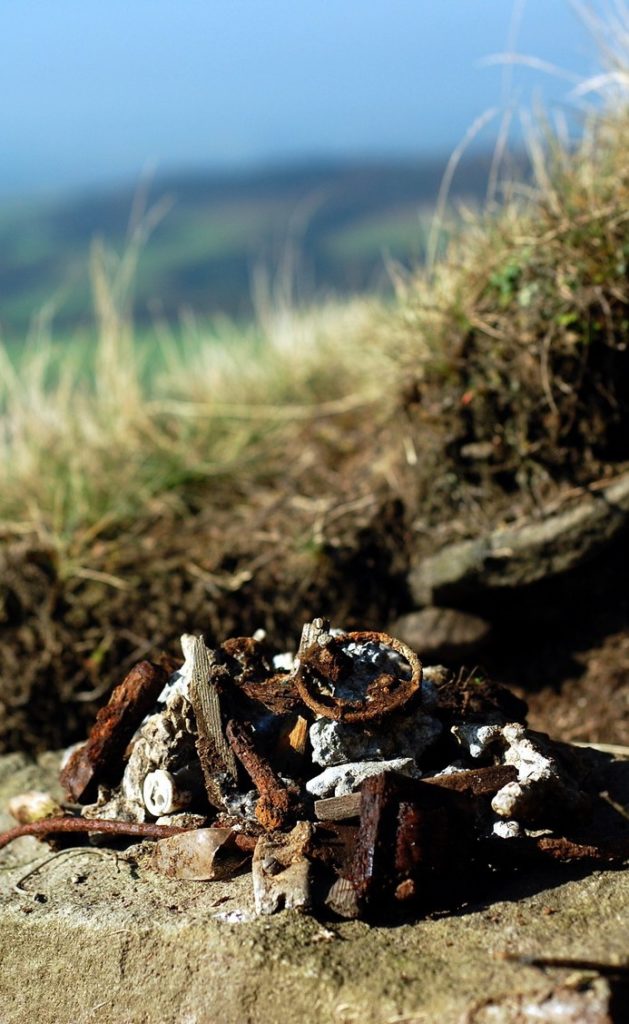Railway Air Services de Havilland DH-84 Dragon G-ADEE
‹ Return to Air Crash Sites

Railway Air Services de Havilland DH-84 Dragon G-ADEE
Pile of fragmentary remains collected at the crash site of a scheduled civil flight from Manchester to the Isle of Man, 26 October 1935.
The pilot of the DH-84, Captain Cedric Rex Crow had picked up the only passenger, a Mr Ronald Swales, at Liverpool.
Soon after taking off the aircraft drifted off course in poor visibility and was flying too low to clear the ridge of Fair Snape Fell in the Forest of Bowland, Lancashire. Captain Crow may have seen the steeply rising hillside at the last instant and pulled back on the stick in an attempt to lift the aircraft over the top of the hill. Both men died in the crash.
Great photo – excellent use of dof and another interesting narrative! Surprising anything is left of the wreckage.
Interesting stuff. Unlucky not to clear the ridge… very sad.
Nice one Ian , I came down from the cairn to the site so missed the great view from the farm up to it !
[http://www.flickr.com/photos/32431958@N07]
I did the same, then carried on round to the Blenheim. Took that photo walking through farmland back to the car.
another great set ian very intersting.
thanks man
Looks like they were very low ?Like your focus here Ian.
PS I’m on Mock the Week next week:-)
Another lovely photograph with a sad story behind it. I like your use of selective focus and the wonderful textures.
Nice one, great narrative, lovely DoF!
brilliant photo ian and story ive flown in one of those when i was about 9yr old
Another sad story Ian, beautifully told through your photos and poignant words !!!!!:-)
[http://www.flickr.com/photos/andyholmfirth] In the Audience i assume?
[http://www.flickr.com/photos/andyholmfirth] In the Audience i assume?
Great shot Ian
You are wonderful historian Ian
fab shot, your choice in shallow dof works a treat. really highlights how to me how what we feel are big events are still quite small in the scheme of things, and also, how tragic that the lives of two men should be lost because they elect to fly – two lives reduced to wreckage.
Very well composed Ian –
[http://www.flickr.com/photos/andyholmfirth] Now i understand where your coming from Andi
Great



I think it might have been better if he hadn’t spotted the hill then they wouldn’t have known what they hit, not much left of the plane I see.
..spotted this :-
[http://www.flickr.com/photos/31878512@N06]
That’s how a removed wreckage should be displayed.
Superb colors…………..well composed man!!!
Janwillem
Nice Shot with sad story.
Thanks for your comment. Yeah mum was fine. Bad headache for a couple of days and a bit of a pain with dressing it whilist in Patagonia. Otherwise it was fine. It was only 4 days into the 3 wks trip as well!!
Nice work mate, the inclusion of the second picture helps tell the story really well. Another one that oh so nearly made it.
Yes another fine effort Ian 🙂 So near to getting away with it… How on Earth did he get to the Trough of Bowland from Speke when going to Manchester/Isle of Man????
The SM79 pic in a desert setting is quite sad…
One such incident befell MM.23881 of the 278th, which took off at 1725 hours on 21 April 1941, captained by Oscar Cimolini, with the intention of searching for enemy shipping near Crete. The SM.79 carried out an attack at around 20:00 hours, and then began the trip back to its base near Benghazi. The crew became disoriented and unable to locate their exact position, missing their airfield in bad weather conditions. Their radio was broken and they were unable to communicate. They were also unaware that they had reached the African coast. The fuel supply was exhausted at around 23:00, and the aircraft made a forced landing some 500 km (310 mi) away from its base. Most of the crew of six had suffered some injuries, but one crew member, Romanini, was able to leave to search for help. He walked for over 90 km (60 mi) in the desert, and finally was overcome and died only a few kilometres from a road, where his remains were found in 1960. Subsequent searches led to the discovery of the SM.79 and the remains of the rest of the crew.
This amazing display at Volandia museum (Milan Malpensa airport) was made used parts of other SIAI MArchetti S.79 to represent the fate of MM.23881.
Another superb piece of work Ian. Desperately lost and low. Not a good combination in claggy weather and yet very very common in those days even amongst highly trained military crews e.g. the round the world Vulcan flight crash. The additional piece on the SM.79 is also very moving and, as you say, superbly reconstructed.
Many thanks everyone.
[http://www.flickr.com/photos/7749921@N04]
yeah that’s a very sad story but a great presentation though.